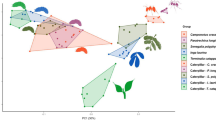Abstract
The ghost crab,Ocypode quadrata, was tested in the field for its ability to locate sources of volatile cues. The pure compound skatole, 3-methylindole, was a potent attractant. Crabs also located sources of complex odors such as dead fish,Lutjanus campechanus, dead mole crabs,Emerita talpoida; and peeled bananas. Ghost crabs possess concealed and reduced antennules that may not be the primary olfactory organs. Chemosensory hairs borne on the dactyls may be the primary detection system.
Similar content being viewed by others
References
Cronin, T.W. 1986. Optical design and evolutionary adaptation in crustacean compound eyes.J. Crust. Biol. 6(1):1–23.
Cronin, T.W., andForward, R.B., Jr. 1988. The visual pigments of crabs. I. Spectral characteristics.J. Comp. Physiol. A. 162:463–478.
Daumer, K., Jander, R., andWaterman, T.H. 1963. Orientation of the ghost crabOcypode quadrata in polarized light.Z. Vergl. Physiol. 47:56–76.
David, C.T., Kennedy, J.S., Ludlow, A.R., Perry, J.N., andWall, C. 1982. A reappraisal of insect flight towards a distant point source of wind-borne odor.J. Chem. Ecol. 8:1207–1215.
Derby, C.D., andAtema, J. 1982. Chemosensitivity of walking legs of the lobsterHomarus americanus: Neurophysiological response spectrum and thresholds.J. Exp. Biol. 98:303–315.
Hazlett, B. A. 1971. Chemical and chemostatic stimulation of feeding behavior in the hermit crabPetrochirus diogenes.J. Comp. Physiol. 39A:665–670.
Hutchison, L.V., andWenzel, B.M. 1980. Olfactory guidance in foraging by procellariforons.Condor 82:314–319.
Rittschof, D., andSutherland, J.P. 1986. Field studies on chemically mediated behavior in land hermit crabs: Volatile and nonvolatile odors.J. Chem. Ecol. 12:1273–1284.
Rittschof, D., Kieber, D., andMerrill, C.L. 1984. Modification of responses of newly hatched snails by exposure to odors during development.Chem. Sens. 9(3):181–192.
Rittschof, D., Barlow, L., andSchmidt, A. 1985. Laboratory studies of olfaction and taste in land hermit crabsCoenobita rugosis.Am. Soc. Zool. 25(abstract 597):113A.
Robertson, J.R., Bankroft, K., Vermeer, G., andPlaisier, K. 1980. Experimental studies on the foraging behavior of the sand fiddler crabUca pugilator (Bosc).J. Exp. Mar. Biol. Ecol. 44:67–83.
Robertson, J.R., Fudge, J.A., andVermeer, G.K. 1981. Chemical and live feeding stimulants of the sand fiddler crab,Uca pugilator (Bosc).J. Exp. Mar. Biol. Ecol. 53:47–64.
Sokal, R.R., andRohlf, F.J. 1981. Biometry. W.H. Freeman, San Francisco, California. 829 pp.
Stecher, P.G. (ed.). 1960. The Merck Index of Chemicals and Drugs, 7th ed. Merck and Co., Rathway, New Jersey. 1642 pp.
Trott, T.J. 1987. Chemoreception by the painted ghost crabOcypode gaudichaudii H. Milne Edwards and Lucas (Brachyura: Ocypodidae): Implications for foraging.Zool. Auz. 218:295–303.
Trott, T.J., andRobertson, J.R. 1984. Chemical stimulants of cheliped flexion behavior by the western Atlantic ghost crabOcypode quadrata (Fabricius).J. Exp. Mar. Biol. Ecol. 78:237–252.
Wolcott, T.G. 1978. Ecological role of ghost crabs,Ocypode quadrata (Fabricius) on an open beach: Scavengers or predators?J. Exp. Mar. Biol. Ecol. 31:67–82.
Author information
Authors and Affiliations
Rights and permissions
About this article
Cite this article
Wellins, C.A., Rittschof, D. & Wachowiak, M. Location of volatile odor sources by ghost crabOcypode quadrata (Fabricius). J Chem Ecol 15, 1161–1169 (1989). https://doi.org/10.1007/BF01014819
Received:
Accepted:
Issue Date:
DOI: https://doi.org/10.1007/BF01014819




